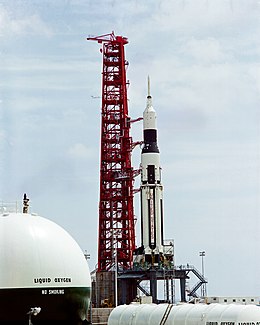 AS-101 (SA-6) | |
| Mission type | Spacecraft aerodynamics |
|---|---|
| Operator | NASA |
| COSPAR ID | 1964-025A |
| SATCAT no. | 800 |
| Mission duration | ~5 hours, 53 minutes |
| Orbits completed | 54 |
| Spacecraft properties | |
| Spacecraft | Apollo BP-13 |
| Launch mass | 7,700 kilograms (17,000 lb) |
| Start of mission | |
| Launch date | May 28, 1964, 17:07:00 UTC |
| Rocket | Saturn I SA-6 |
| Launch site | Cape Kennedy LC-37B |
| End of mission | |
| Disposal | Uncontrolled reentry |
| Last contact | May 28, 1964 after 4 orbits |
| Decay date | June 1, 1964 |
| Orbital parameters | |
| Reference system | Geocentric |
| Regime | Low Earth orbit |
| Perigee altitude | 178 kilometers (96 nmi) |
| Apogee altitude | 199 kilometers (107 nmi) |
| Inclination | 31.7 degrees |
| Period | 88.26 minutes |
| Epoch | 30 May 1964[1] |
AS-101 (also designated SA-6) was the sixth flight of the Saturn I launch vehicle, which carried the first boilerplate Apollo spacecraft into low Earth orbit.[2][3] The test took place on May 28, 1964, lasting for four orbits (about six hours). The spacecraft and its upper stage completed a total of 54 orbits before reentering the atmosphere and crashing in the Pacific Ocean on June 1, 1964.
The flight experienced a single anomaly: one of the eight first-stage Saturn I engines shut down early, but the guidance system compensated by burning the remaining seven engines longer. AS-101 was followed by four more flights to verify the launch aerodynamics of the Apollo command and service module (CSM) and its launch escape system (LES) tower.
- ^ McDowell, Jonathan. "Satellite Catalog". Jonathan's Space Page. Retrieved October 31, 2013.
- ^ "NASA: SA-6". Archived from the original on May 14, 2011. Retrieved December 8, 2003.
- ^ NSSDC: SA-6